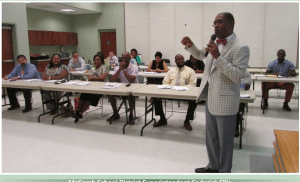Supporting Practitioners in McComb
CompetencyWorks Blog

This is the eighth post on a series about McComb School District in McComb, Mississippi. Start here.
How is McComb School District supporting practitioners (teachers) in the transition to a personalized, competency-based system? They are trying out different strategies to figure out what might work best.
– Frontloading was too much: They started with twenty days of professional development over the summer to the Summit practitioners. But they discovered that it was too much frontloading. Practitioners needed bite-size pieces of professional development with opportunity to implement a few practices, reflect, and finetune before taking on the next set of practices. They feel that twenty days is needed to cover the full mix of pedagogy, personalized learning that empowers scholars, competency-based, and blended – but just not at one time.
– Micro-credentialing is helpful but not powerful enough: They have also tried micro-credentialing. As they introduced blended learning practices, they had practitioners identify a skill that they wanted to build, and, when they had demonstrated it, they received a micro-credential. It has been helpful but isn’t enough to dramatically change practice.
– Professional learning communities to transfer knowledge and build consistency: They are now working with a model that has practitioners in one grade level from two different elementary schools working together as a monthly professional learning community. They want to have all personalized learning practitioners participating in a PLC so they can transfer knowledge across schools, begin to moderate expectations of what it means to be proficient, and build up a districtwide approach to personalized learning.
McComb’s goal is to provide support to practitioners in the following areas:
- Developing a mindset for high expectations and growth: Exploring what it means to design a system that supports all scholars. Supporting adults to develop their growth mindset and understand how to support scholars in developing it.
- Creating personalized learning environments: Understanding classroom management practices for a personalized learning environment includes shared vision, target trackers, and others.
- Planning for instruction in personalized environment: Developing units that support personalized learning with scholars working on different standards.
- Assessing for mastery: Building assessment literacy on formative assessments and how to determine proficiency.
- Using data to inform instruction: Developing strategies to help scholars use data, and using data to inform instruction and professional learning.
- Using technology to support personalized learning: What are the types of technological resources available and how to use them.
Stephen Johnson, Data Analyst and Personalized Learning Coach, noted that it was important to put technology last, otherwise, practitioners became focused on how to use the technology and didn’t focus enough on the larger, more important changes of what it means to move to personalized learning. Johnson also mentioned that introducing technology had created changes for the district as well. “We started with a ‘whatever you need’ mentality,” he said. “Over time, we have become more careful in wanting to make sure the tools are the most beneficial. It takes times for practitioners to become experts in a technological resource and be able to maximize its benefits.” Superintendent Cederick Ellis concurred with, ”More is not better in the case of technology.”

They explained that the more technological tools that were used, the more data was generated about scholar learning. Too much data to be useful, it turns out. Johnson explained, “There is a sweet spot somewhere, but we haven’t found ours yet. It feels like every technological resource is valuable when you first use it. However, every program produces data to be analyzed, such as the amount of time scholars used it, their performance, and when they used it. What do you do with it all? We are trying to narrow down the data, integrate it, and create a pipeline that can help scholars, practitioners, principals, and the district.”
Lakya Washington, Summit Elementary’s Lead Learner added, “We want to understand the strengths and deficits scholars bring to the task. So we began to ask which resources provide us with the best, most helpful information. Scantron has been a helpful partner. They helped us get information on gaps and suggested areas of focus for each scholar. Every kid has a different learning path because of their gaps.”
Going forward, McComb is organizing professional learning into two categories. First are the topics related to mindsets, classroom management, and instruction. The second is how technology can support learning, including how to use data.
Read the Entire Series:
- Post 1 – Personalizing the Learning in McComb, Mississippi
- Post 2 – McComb’s Six Pillars of Student-Centered Learning
- Post 3 – McComb’s Strategic Planning Begins with the Community
- Post 4 – Piloting Change in McComb
- Post 5 – Empowering Scholars at McComb’s Summit Elementary
- Post 6 – Starting with the Kindergarteners in McComb
- Post 7 – Starting the Journey to CBE at Otken Elementary School
- Post 8 – Supporting Practitioners in McComb